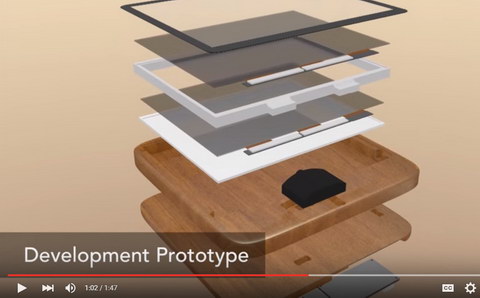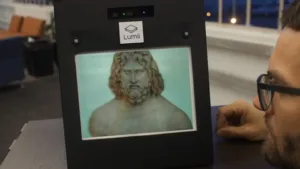Lumii Inc. (http://www.lumiidisplay.com/), a start-up spin-out from the Massachusetts Institute of Technology (MIT), was one of 26 winners of seed money from the MassChallenge (http://masschallenge.org/). The MassChallenge organization’s goal is to encourage startups and innovation, and not just startups in Massachusetts. They accept applications from anywhere in the world and have special programs for the UK and Israel. In addition, MassChallenge provides incubator space for start-ups in Boston. Lumii’s share of the $1.5M grant money this year was $50,000. This money is provided as a no-equity grant and does not dilute the start-up ownership.
The three Lumii founders are Dr. Tom Baran, Chief Executive Officer; Dr. Matt Hirsch, Chief Technical Officer; and Dr. Daniel Leithinger, Chief Design Officer. All three are veterans of MIT, with Dr. Baran coming out of the MIT Research Laboratory of Electronics and Drs. Hirsch and Leithinger coming from the MIT Media Lab.
Lummi automultiscopic demonstrator. On the Lumii website, the display is rotated back and forth to show the glasses-free 3D image.
I got in touch with Dr. Baran to ask about the company’s glasses-free 3D technology. Not surprisingly, he declined to discuss the technology in detail at this point. He did say, “At Lumii we know how to create high-quality, glasses free 3D (automultiscopic) displays. We do it by arranging commodity display components, and driving the components using sophisticated algorithms. You can think of us as a fabless, software-defined display company. Our basic product is real-time software whose input is information that designers know how to work with (e.g. 3D models or 3D scenes) and whose output is sets of patterns that, when displayed on a stack of commodity LCD panels, produces a high-quality automutiscopic image.”
There is a YouTube video on line (https://youtu.be/FHqRFCCk4IU) with the three founders discussing mostly the potential application of their technology, rather than the technology itself. The exploded view of a display used in this article comes from that YouTube video. When asked about this image, Dr. Hirsch said, “While the video you referenced does show the gist of one of our prototypes – two LCD layers – it is more of a sketch for the MassChallenge business plan judges. I hope some of the past results from the MIT work will give you a better flavor of what’s to come.”
 Two LCD version of the Lummi automultiscopic technology used for the MassChallenge.
Two LCD version of the Lummi automultiscopic technology used for the MassChallenge.
One of these articles from MIT is from 2012 and posted on the MIT News web site at http://news.mit.edu/2012/glasses-free-3d-television-0712. Included on this website is a video by Matt Hirsch and two of his MIT colleagues at the time, Douglas Lanman and Professor Ramesh Raskar, explaining the technology. While the image above shows only two LCD panels, the video discusses similar systems with two, three and four layers of display panels. The video says two key recent display technology developments enable their software-based display systems. First are modern high-speed large area LCD displays. Second is the availability of very high speed computational platforms, e.g. smartphone processors. The video shows the 3D image taken with a camera whose temporal sensitivity matches human vision and shows smooth motion in 3D. Another portion of the video shows images taken with a much faster camera and shows the images are actually built up of various segments that the eye integrates together into 3D. –Matthew Brennesholtz

